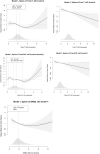Circulating Androgen Concentrations and Risk of Incident Heart Failure in Older Men: The Cardiovascular Health Study
- PMID: 36285783
- PMCID: PMC9673636
- DOI: 10.1161/JAHA.122.026953
Circulating Androgen Concentrations and Risk of Incident Heart Failure in Older Men: The Cardiovascular Health Study
Abstract
Background Circulating androgen concentrations in men decline with age and have been linked to diabetes and atherosclerotic cardiovascular disease (ASCVD). A similar relationship has been reported for low total testosterone and incident heart failure (HF) but remains unstudied for free testosterone or the more potent androgen dihydrotestosterone (DHT). We hypothesized that total/free testosterone are inversely related, sex hormone-binding globulin is positively related, and total/free DHT bear a U-shaped relationship with incident HF. Methods and Results In a sample of men from the CHS (Cardiovascular Health Study) without atherosclerotic cardiovascular disease or HF, serum testosterone and DHT concentrations were measured by liquid chromatography-tandem mass spectrometry, and sex hormone-binding globulin by immunoassay. Free testosterone or DHT was calculated from total testosterone or total DHT, sex hormone-binding globulin, and albumin. We used Cox regression to estimate relative risks of HF after adjustment for potential confounders. In 1061 men (aged 76±5 years) followed for a median of 9.6 years, there were 368 HF events. After adjustment, lower calculated free testosterone was significantly associated with higher risk of HF (hazard ratio [HR], 1.14 [95% CI, 1.01-1.28]). Risk estimates for total testosterone (HR, 1.12 [95% CI, 0.99-1.26]), total DHT (HR, 1.10 [95% CI, 0.97-1.24]), calculated free dihydrotestosterone (HR, 1.09 [95% CI, 0.97-1.23]), and sex hormone-binding globulin (HR, 1.07 [95% CI, 0.95-1.21]) were directionally similar but not statistically significant. Conclusions Calculated free testosterone was inversely associated with incident HF, suggesting a contribution of testosterone deficiency to HF incidence among older men. Additional research is necessary to determine whether testosterone replacement therapy might be an effective strategy to lower HF risk in older men.
Keywords: aging; heart failure; men; sex hormones; testosterone.
Figures


References
-
- Virani SS, Alonso A, Aparicio HJ, Benjamin EJ, Bittencourt MS, Callaway CW, Carson AP, Chamberlain AM, Cheng S, Delling FN, et al. Heart disease and stroke statistics—2021 update: a report from the American Heart Association. Circulation. 2021;143:e254–e743. doi: 10.1161/CIR.0000000000000950 - DOI - PubMed
-
- Conrad N, Judge A, Tran J, Mohseni H, Hedgecott D, Crespillo AP, Allison M, Hemingway H, Cleland JG, McMurray JJV, et al. Temporal trends and patterns in heart failure incidence: a population‐based study of 4 million individuals. Lancet. 2018;391:572–580. doi: 10.1016/S0140-6736(17)32520-5 - DOI - PMC - PubMed
Publication types
MeSH terms
Substances
Grants and funding
- HHSN268201200036C/HL/NHLBI NIH HHS/United States
- HHSN268200800007C/HL/NHLBI NIH HHS/United States
- HHSN268201800001C/HL/NHLBI NIH HHS/United States
- N01HC85079/HL/NHLBI NIH HHS/United States
- N01HC85081/HL/NHLBI NIH HHS/United States
- N01HC85082/HL/NHLBI NIH HHS/United States
- N01HC85086/HL/NHLBI NIH HHS/United States
- 75N92021D00006/HL/NHLBI NIH HHS/United States
- U01 HL080295/HL/NHLBI NIH HHS/United States
- U01 HL130114/HL/NHLBI NIH HHS/United States
- R01 AG023629/AG/NIA NIH HHS/United States
- K24 HL135413/HL/NHLBI NIH HHS/United States
LinkOut - more resources
Full Text Sources
Medical
Research Materials
Miscellaneous

